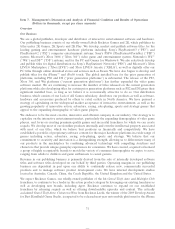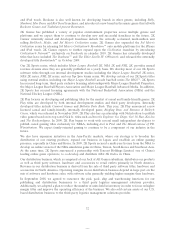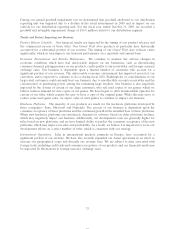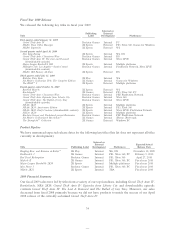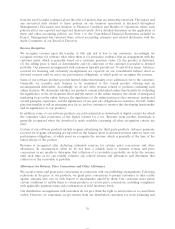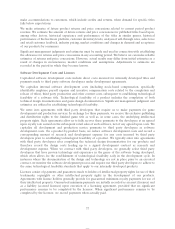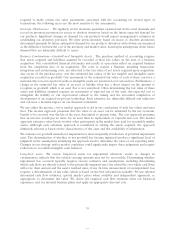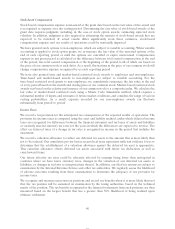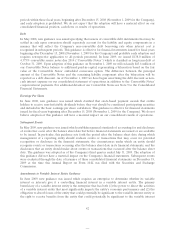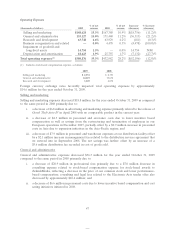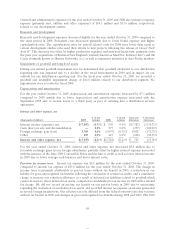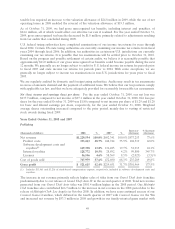2K Sports 2009 Annual Report Download - page 44
Download and view the complete annual report
Please find page 44 of the 2009 2K Sports annual report below. You can navigate through the pages in the report by either clicking on the pages listed below, or by using the keyword search tool below to find specific information within the annual report.required to make certain fair value assessments associated with the accounting for several types of
transactions, the following areas are the most sensitive to the assessments:
Inventory Obsolescence. We regularly review inventory quantities on-hand and in the retail channels and
record an inventory provision for excess or obsolete inventory based on the future expected demand for
our products. Significant changes in demand for our products would impact management’s estimates in
establishing our inventory provision. We write down inventory based on excess or obsolete inventories
determined primarily by future anticipated demand for our products. Inventory write-downs are measured
as the difference between the cost of the inventory and market value, based upon assumptions about future
demand that are inherently difficult to assess.
Business Combinations—Goodwill and Intangible Assets. The purchase method of accounting requires
that assets acquired and liabilities assumed be recorded at their fair values on the date of a business
acquisition. Our consolidated financial statements and results of operations reflect an acquired business
from the completion date of an acquisition. The costs to acquire a business, including transaction,
integration and restructuring costs, are allocated to the fair value of net assets acquired upon acquisition.
Any excess of the purchase price over the estimated fair values of the net tangible and intangible assets
acquired is recorded as goodwill. Our assessment of the estimated fair value of each of these can have a
material effect on our reported results as intangible assets are amortized over various lives. Furthermore, a
change in the estimated fair value of an asset or liability often has a direct impact on the amount to
recognize as goodwill, which is an asset that is not amortized. Often determining the fair value of these
assets and liabilities assumed requires an assessment of expected use of the asset, the expected cost to
extinguish the liability or our expectations related to the timing and the successful completion of
development of an acquired in-process technology. Such estimates are inherently difficult and subjective
and can have a material impact on our financial statements.
We use either the income, cost or market approach to aid in our conclusions of such fair values and asset
lives. The income approach presumes that the value of an asset can be estimated by the net economic
benefit to be received over the life of the asset, discounted to present value. The cost approach presumes
that an investor would pay no more for an asset than its replacement or reproduction cost. The market
approach estimates value based on what other participants in the market have paid for reasonably similar
assets. Although each valuation approach is considered in valuing the assets acquired, the approach
ultimately selected is based on the characteristics of the asset and the availability of information.
We evaluate our goodwill annually for impairment or more frequently if indicators of potential impairment
exist. The determination of whether or not goodwill has become impaired involves a significant level of
judgment in the assumptions underlying the approach used to determine the value of our reporting units.
Changes in our strategy and/or market conditions could significantly impact these judgments and require
reductions to recorded intangible asset balances.
Long-lived assets. We review long-lived assets for impairment whenever events or changes in
circumstances indicate that the related carrying amounts may not be recoverable. Determining whether
impairment has occurred typically requires various estimates and assumptions, including determining
which cash flows are directly related to the potentially impaired asset, the useful life over which cash flows
will occur, their amount and the asset’s residual value, if any. In turn, measurement of an impairment loss
requires a determination of fair value, which is based on the best information available. We use internal
discounted cash flow estimates, quoted market prices when available and independent appraisals, as
appropriate, to determine fair value. We derive the required cash flow estimates from our historical
experience and our internal business plans and apply an appropriate discount rate.
39




